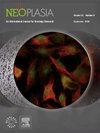肝素酶在转移性黑色素瘤细胞中调节FGF2的结合、信号传导和血管生成。
IF 7.7
2区 医学
Q1 ONCOLOGY
引用次数: 77
摘要
肝素酶(HPSE)和成纤维细胞生长因子-2 (FGF2)是黑色素瘤血管生成和转移的关键调节因子。HPSE表达升高有助于黑色素瘤的进展;然而,进一步增加HPSE的存在可以抑制致瘤性。HPSE酶切硫酸肝素糖胺聚糖链(HS)从蛋白聚糖。HS在高亲和FGF2受体的形成过程中同时作为低亲和FGF2受体和辅助受体。我们研究了HPSE通过HS重塑调节FGF2活性的能力。人类转移性黑色素瘤细胞(70W)广泛的HPSE降解抑制FGF2结合。出乎意料的是,用低HPSE浓度处理70W细胞增强了FGF2的结合。此外,未暴露于hpse的细胞对FGF2没有磷酸化细胞外信号相关激酶(ERK)或局灶黏附激酶(FAK)。相反,在HPSE处理的细胞中,FGF2刺激ERK和FAK磷酸化。其次,在低HS浓度下,可溶性hpse降解HS的存在增强了FGF2的结合和ERK的磷酸化。较高浓度的可溶性HS抑制了FGF2的结合,但通过ERK的FGF2信号传导仍然增强。无论HPSE处理如何,可溶性HS都不能支持fgf2刺激的FAK磷酸化。最后,细胞暴露于HPSE或HPSE降解的HS可调节黑色素瘤中fgf2诱导的血管生成。总之,这些效应提示了HPSE调节黑色素瘤生长因子反应性和致瘤性的相关机制。本文章由计算机程序翻译,如有差异,请以英文原文为准。
FGF2 binding, signaling, and angiogenesis are modulated by heparanase in metastatic melanoma cells.
Heparanase (HPSE) and fibroblast growth factor-2 (FGF2) are critical regulators of melanoma angiogenesis and metastasis. Elevated HPSE expression contributes to melanoma progression; however, further augmentation of HPSE presence can inhibit tumorigenicity. HPSE enzymatically cleaves heparan sulfate glycosaminoglycan chains (HS) from proteoglycans. HS act as both low-affinity FGF2 receptors and coreceptors in the formation of high-affinity FGF2 receptors. We have investigated HPSE's ability to modulate FGF2 activity through HS remodeling. Extensive HPSE degradation of human metastatic melanoma cells (70W) inhibited FGF2 binding. Unexpectedly, treatment of 70W cells with low HPSE concentrations enhanced FGF2 binding. In addition, HPSE-unexposed cells did not phosphorylate extracellular signal-related kinase (ERK) or focal adhesion kinase (FAK) in response to FGF2. Conversely, in cells treated with HPSE, FGF2 stimulated ERK and FAK phosphorylation. Secondly, the presence of soluble HPSE-degraded HS enhanced FGF2 binding and ERK phosphorylation at low HS concentrations. Higher concentrations of soluble HS inhibited FGF2 binding, but FGF2 signaling through ERK remained enhanced. Soluble HS were unable to support FGF2-stimulated FAK phosphorylation irrespective of HPSE treatment. Finally, cell exposure to HPSE or to HPSE-degraded HS modulated FGF2-induced angiogenesis in melanoma. In conclusion, these effects suggest relevant mechanisms for the HPSE modulation of melanoma growth factor responsiveness and tumorigenicity.
求助全文
通过发布文献求助,成功后即可免费获取论文全文。
去求助
来源期刊

Neoplasia
ONCOLOGY-
自引率
2.10%
发文量
82
期刊介绍:
Neoplasia publishes the results of novel investigations in all areas of oncology research. The title Neoplasia was chosen to convey the journal’s breadth, which encompasses the traditional disciplines of cancer research as well as emerging fields and interdisciplinary investigations. Neoplasia is interested in studies describing new molecular and genetic findings relating to the neoplastic phenotype and in laboratory and clinical studies demonstrating creative applications of advances in the basic sciences to risk assessment, prognostic indications, detection, diagnosis, and treatment. In addition to regular Research Reports, Neoplasia also publishes Reviews and Meeting Reports. Neoplasia is committed to ensuring a thorough, fair, and rapid review and publication schedule to further its mission of serving both the scientific and clinical communities by disseminating important data and ideas in cancer research.
 求助内容:
求助内容: 应助结果提醒方式:
应助结果提醒方式:


